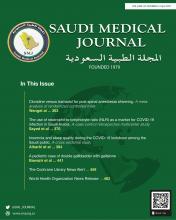Systematic Review
Clonidine versus tramadol for post spinal anesthesia shivering. A meta-analysis of randomized controlled trials
Wang et al compare clonidine with tramadol for shivering control following spinal anesthesia. Initially, 476 studies were found. After assessment, 22 full texts were included; however, 8 articles were excluded because they involved children or animals, or were non-RCTs or correspondences. Fourteen studies with 960 patients were identified. Clonidine demonstrated a lower effective rate of shivering control, but with decreased occurrence of nausea, vomiting, and dizziness. It increased the occurrence of bradycardia, hypotension, and sedation compared to tramadol. Tramadol is more effective for shivering control than clonidine, but with increased occurrence of nausea, vomiting, and dizziness.
see page 363
Original Articles
The use of neutrophil-to-lymphocyte ratio (NLR) as a marker for COVID-19 infection in Saudi Arabia. A case-control retrospective multicenter study
Sayed et al assess the neutrophil-to-lymphocyte ratio (NLR) diagnostic and prognostic value in the context of Coronavirus disease-2019 (COVID-19) infection in Saudi Arabia. A case-control study with 701 confirmed COVID-19 patients and 250 control subjects were enrolled. Patients of which 54.8% were females, were younger than the control cohort. Patients had significantly higher NLR compared to the control group. Intensive care unit admitted patients had significantly higher platelet, white blood cells, and neutrophil counts.
Comparisons of neutrophil-to-lymphocyte ratios (NLR) between the control and COVID-19 cohorts.
see page 370
Insomnia and sleep quality during the COVID-19 lockdown among the Saudi public. A cross-sectional study
Alharbi et al show that during the COVID-19 pandemic, the Saudi population had a high prevalence of insomnia and poor sleep quality. A total of 790 responses were included and the majority of participants were the Saudi population 735. The prevalence of insomnia was 54.4% and poor sleep quality was 55.5%. Saudi citizenship was associated with longer sleep duration. An internet-based questionnaire that was performed during the lockdown of the COVID-19 pandemic among the Saudi population over 2 weeks to measure the Saudi population’s sleep quality during the lockdown.
Pittsburgh sleep quality index score in Saudi population.
see page 384
Case Report
A pediatric case of double gallbladder with gallstone
Bawazir et al present a child suffered from a congenital heart disease who presented with double gallbladder having gallstones. A 4-year-old female with congenital heart disease particularly a dextro-transposition of the great arteries with a large atrial septal defect, which have been corrected by surgery at age of 14-months. The case was resolved via surgical intervention without postoperative complications. In case of symptomatic patients, it is recommended to get rid of both the gallbladders so as to prevent the recurrence of the disease on the other bladder later in life.
Two gallstone in the superficial gallbladder, one at the neck and the other at the funds (arrows).
- Copyright: © Saudi Medical Journal
This is an open-access article distributed under the terms of the Creative Commons Attribution-Noncommercial License (CC BY-NC), which permits unrestricted use, distribution, and reproduction in any medium, provided the original work is properly cited.









